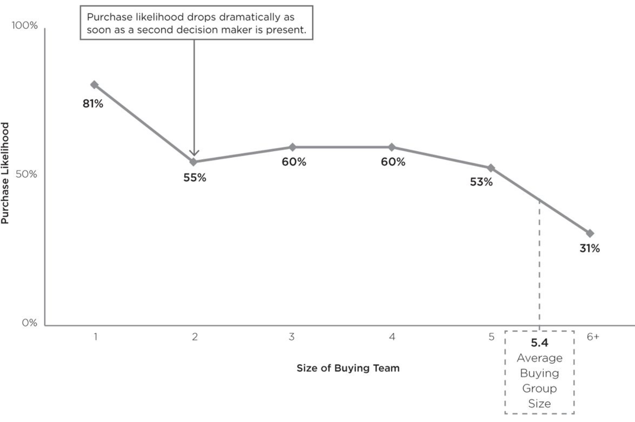Why Buyers Have Lost Their Ability to Reach Decisions

Survey today’s Business-to-Business (B2B) salespeople, you will most likely hear rumblings that selling is more arduous, takes more effort, with more drawn out, longer sales cycles than ever before. What happened? Did customer really lose the ability to make decisions? How can this be addressed by the sales team?
A fellow B2B SaaS vendor in the cloud software industry we spoke with recently stated that “we gathered our statistics on lost and stalled deals and found out that the majority of deals were not lost to competition. They actually ended up with no decision at all.”
What?!
This news is alarming. It is most likely caused by the fact that today’s decision makers involve multiple stakeholders in the decision making process.
Do more opinions equal greater buy-in?
A highly successful VP of operations at a UK-based bank traditionally made decisions without involving many of his people. Recently, he changed his company’s decision making process and added six people from different departments to be involved in the buying decisions.
When we asked him what has driven him to do this, he explained his position. “We have done way too many purchases that failed to achieve the return on investment (ROI) targets simply because the team and users didn’t adapt to it. To minimize this as a consequence, I now involve them in the decision process, and garner consensus from the beginning, before we purchase, so they carry the mutual decision and drive adaption.
According to CEB, who interviewed 3000 decision makers, this is a common trend.
In their current book “The Challenger Customer”, they point out that the average deal is decided by 5.4 decision makers. Gaining five or more stakeholders’ buy-in is exponentially more difficult than receiving approval from a single decision maker. While writing this line, I was reminded of my last family decision to be made, picking a movie to watch on Netflix, which took a minimum of 30 minutes.
Too many cooks spoil the soup. Or, in this case, the decision.

The reason is clear.
Every decision maker adds his or her own criteria, resulting in diverse opinions that are frequently at odds with another. Each stakeholder’s mindset comes from their different motivations, i.e. legal concerned with compliance, business users concerned about the usability of yet another tool, management needs a proper report on KPI’s and IT is worried about operational cost. This environment is the reason the “making no decision” verdict is seen more often now, given the diversity, missing communication, and fragmented goals of the people involved.
So, what can sales do to drive a decision’s progress inside corporations?
In order for salespeople to effectively navigate the buying process with multiple decision makers, they must first understand the decision process, and who is involved. Way too many times we rely on ONE single customer contact to make the deal when in average there are 5,4 involved. This represents a coverage of 18,5% of the stakeholders. That is way too risky!
What is the customer’s pain point and how can your solution or product solve the issue?
To be successful, it’s vital that the salesperson meets with all the relevant decision makers individually and asks in-depth questions that go beyond what he/she thinks they want. It’s not surprising that the perception of the pain differs from the angle you look at it. So after multiple discovery sessions the salesperson usually has a better holistic insight to the main issues than the customer stakeholders themselves.
You as the salesperson must uncover the actual and overarching pain point, and then understand how each player’s needs are addressed with your product. After all, a buyer may think he wants a drill when what he really wants is a hole.
How does a customer perceive this pain? Is it a pain at all?
In a multiple-decision-maker climate, some of the participants may feel your product is absolutely necessary, while others regard it as a waste of resources. As mentioned before pain points differ so its important to identify the “common denominator” that the players in the decision process can agree upon solving.
What happens if nothing happens? What is the “business” implication?
Here is where many salespeople fail to identify the pain’s implication for the client. If the client doesn’t reach a decision, will somebody be in serious trouble? How will it affect the company’s performance? Will the business suffer? Will competition gain the upper hand?
If the answers are yes, then you are already building a strong case to fight the status quo. If the answers are no, your project will probably lose momentum and will be outrun by other priorities which are of higher interest to the business.
How can the process be moved forward?
Once the outcome of non-action is identified, pinpoint a person who has a personal, vested interest in seeing you succeed. A mentor/champion who gives you insight on what matters, and who is strong enough to influence his peers and managers up the chain.
Once you have identified and won your champion, you can build a case and and set up a strategy together. This is probably the most important step to make sure you can boost priority & urgency, to move out roadblocks, drive decisions and to solve the customers overarching common pain.
This strategy should include these four critical factors:
First of all, it is crucial that you don’t assume or make up the answers to the first 3 points listed below. Discover the answers on every meeting with the client to make sure you collect the ammunition for a strong case to make a decision upon.
- The ultimate reason to buy. Why does the company need to take action and purchase from you? This includes the pain, metrics around the implication, and the consequence of doing nothing. The better you can align to current strategies/projects or outline a severe business impact, the likelier it is to get momentum and priority for your project.
- Why to buy from you. Build a case on why you are unique and superior to your competitors. Don’t assume you are the only vendor engaging the stakeholders, as they are most likely talking with multiple sellers. Make sure you identify the unique differentiators that matter to the client.
- Why purchase now. This needs to include hard metrics outlining the consequence if the client fails to make a decision by a deadline. It sets the priority for the stakeholders to make a definitive decision and elevates your offering to a top priority status for the finance and purchase decisions. There is nothing as sweet as clock ticking with hard quantifiable consequences.
- Gain comprehensive coverage and buy in. Thoroughly communicate with each stakeholder until you are confident this strategy has been circulated amongst the decision makers. Also make certain your allies act as influencers to build a common ground understanding of the nature of the pain and its implication to their business.
Successfully implementing this strategy will motivate the people involved to agree that this is something that needs to be done, even if it was not on top of their priorities. The result is a decision and, hopefully, a sale in your column.
Conclusion.
Today, decision makers aim for consensus among the team before making decisions. This poses potential obstacles for salespeople that must be overcome in order to be successful.
It’s crucial to identify a strong business-related pain point, find one or more allies to quantify this pain, and lay out the measureable consequences for failing to decide. In multi-decision maker buying environments, you must learn to communicate why the stakeholders must take action, why they need to buy from you, and why it needs to happen now. Once you adapt to this new selling strategy, you will see fewer deals fizzle into “no decision” oblivion.





